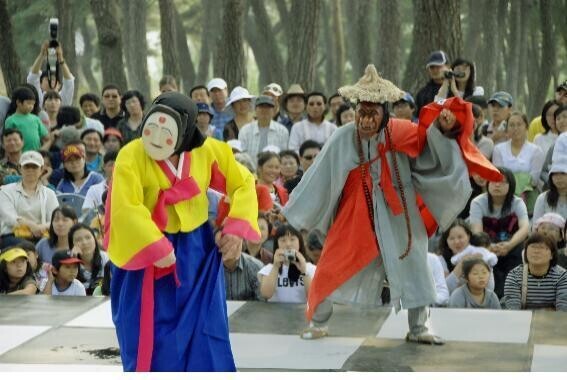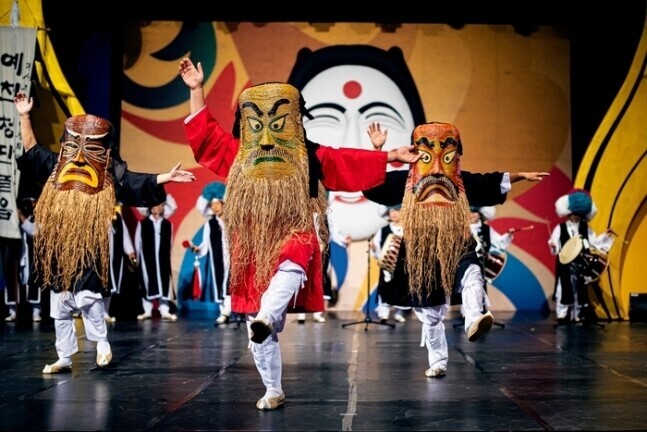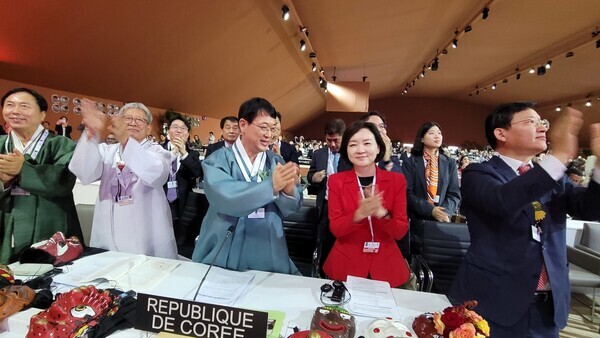hankyoreh
Links to other country sites 다른 나라 사이트 링크
Korean mask dance “talchum” recognized as intangible heritage by UNESCO

South Korea’s traditional mask dancing, called talchum, was officially registered as a world intangible cultural heritage by UNESCO on Wednesday.
The decision to add talchum to the Representative List of the Intangible Cultural Heritage of Humanity came at the 17th session of UNESCO's Intergovernmental Committee for the Safeguarding of the Intangible Cultural Heritage held in Rabat, Morocco. The session had kicked off on Monday and the decision was made on Wednesday morning.
As a result, South Korea now boasts a total of 22 entries registered on the UNESCO Intangible Cultural Heritage of Humanity list, including Jongmyo jeryeak (royal ceremonial music), which was first Korean entry listed in 2001; ssireum (Korean wrestling), which was jointly registered in 2018 by North and South Korea; and yeondeunghoe (Korean lantern-lighting festival), which was listed in 2020.
At the session, UNESCO officials praised South Korea’s talchum for its message of universal equality and criticism of social hierarchy, which they said is still relevant today and added that the masked dancing “can promote and reinforce local cultural identities.”
A total of 13 forms of talchum have been inscribed as national intangible cultural heritages and 5 forms as regional intangible cultural heritages.

The forms of talchum inscribed as national intangible cultural heritages included those from across Korea: Hahoe byeolsingut talnori (the oldest form of mask dance), Yangju byeolsandae nori, Tongyeong ogwangdae, Goseong ogwangdae, Gangneung gwanno gamyeongeuk, Bukcheong sajanoreum, Bongsan talchum, Dongnae yaryu, Gangnyeong talchum, Suyeong yaryu, Songpa sandae nori, Gasan ogwangdae, and Eunyul talchum.
Besides these, the forms of talchum inscribed as regional intangible cultural heritages include Sokcho saja nori, Toegyewon sandae nori, Jinju ogwangdae, Gimhae ogwangdae, and Yecheon cheongdan noreum.
Korea’s talchum is a comprehensive artistic performance that encompasses dance, singing, and theater. Dancers wear masks of people, ghosts, and animals and exchange cheers with the audience while satirizing and criticizing the world, making for a humorous and unique performance.
Talchum can be described as a cultural heritage that aims for unity and mutual respect, without excluding anyone, while addressing social issues of concern to people in a humorous and entertaining way. Another noteworthy point about talchum is how only open space is needed for a performance to be held and how the dancers and audience can communicate with each other in such a vast way just through this one space.

Meanwhile, North Korea’s Pyongyang raengmyon (naengmyeon — cold buckwheat noodles) custom was also registered on UNESCO’s Representative List of the Intangible Cultural Heritage of Humanity. The listing follows that of the folk song Arirang (listed in 2014), kimchi-making (listed in 2015), and ssireum (jointly listed with South Korea in 2018), bringing North Korea’s total heritages registered on this list to four.
By Roh Hyung-suk, culture correspondent
Please direct questions or comments to [english@hani.co.kr]

Editorial・opinion
![[Editorial] Intensifying US-China rivalry means Seoul must address uncertainty with Beijing sooner than later [Editorial] Intensifying US-China rivalry means Seoul must address uncertainty with Beijing sooner than later](https://flexible.img.hani.co.kr/flexible/normal/500/300/imgdb/original/2024/0517/8117159322045222.jpg) [Editorial] Intensifying US-China rivalry means Seoul must address uncertainty with Beijing sooner than later
[Editorial] Intensifying US-China rivalry means Seoul must address uncertainty with Beijing sooner than later![[Column] When ‘fairness’ means hate and violence [Column] When ‘fairness’ means hate and violence](https://flexible.img.hani.co.kr/flexible/normal/500/300/imgdb/original/2024/0516/7417158465908824.jpg) [Column] When ‘fairness’ means hate and violence
[Column] When ‘fairness’ means hate and violence- [Editorial] Yoon must stop abusing authority to shield himself from investigation
- [Column] US troop withdrawal from Korea could be the Acheson Line all over
- [Column] How to win back readers who’ve turned to YouTube for news
- [Column] Welcome to the president’s pity party
- [Editorial] Korea must respond firmly to Japan’s attempt to usurp Line
- [Editorial] Transfers of prosecutors investigating Korea’s first lady send chilling message
- [Column] Will Seoul’s ties with Moscow really recover on their own?
- [Column] Samsung’s ‘lost decade’ and Lee Jae-yong’s mismatched chopsticks
Most viewed articles
- 1[Editorial] Transfers of prosecutors investigating Korea’s first lady send chilling message
- 2S. Korea “monitoring developments” after report of secret Chinese police station in Seoul
- 3[Exclusive] Unearthed memo suggests Gwangju Uprising missing may have been cremated
- 4[Editorial] Intensifying US-China rivalry means Seoul must address uncertainty with Beijing sooner t
- 5China, Russia put foot down on US moves in Asia, ratchet up solidarity with N. Korea
- 6Xi, Putin ‘oppose acts of military intimidation’ against N. Korea by US in joint statement
- 7Truth commission confirms Korean War killings by soldiers and police
- 8[Editorial] South Korean women are mobilizing in unprecedented ways
- 9Calls for gender-equality continue as demonstrations target President Moon
- 10[Column] “Hoesik” as ritual of hierarchical obedience